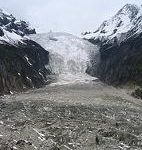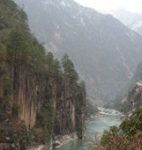Nuclear power: is it a force for good or for evil? Put bluntly, that is the essence of the argument that has preoccupied much of the world for the last 60 years.
To its backers, generating electricity by splitting atoms of uranium is a cheap, clean, safe and secure solution to humanity’s energy needs. To its detractors, however, nuclear power is a costly, dirty, dangerous and destabilising distraction.
Like all crucial and complex issues, there are inevitably truths – and half-truths – on both sides of the argument. As the world stands on the brink of a major expansion of nuclear power, it has rarely been more important to understand the opportunities and the threats posed by one of the planet’s most controversial technologies.
Nuclear power was ushered onto the world stage in August 1945, when the United States (US) dropped atomic bombs on the Japanese cities of Hiroshima and Nagasaki, killing hundreds of thousands of people. After that, there could be no doubting that nuclear fission was capable of releasing huge amounts of energy. The only question was whether it could be tamed.
It didn’t take scientists long to figure out a way of using atoms for peace, instead of war. They controlled fission so that it produced a sustained chain reaction capable of generating enough heat to raise steam and turn turbines. In October 1956, the United Kingdom (UK) opened what was billed as the world’s first civil nuclear power station at Calder Hall in north west England. As well as producing electricity, the station also produced plutonium for nuclear weapons.
Since then, nuclear power has expanded across the globe. According to the UN’s International Atomic Energy Agency (IAEA), there are now 442 nuclear power plants in operation in 30 countries. Five countries have more than 20 plants, including the US (103), France (59), Japan (55), Russia (31) and the UK (23).
The country with the highest proportion of nuclear electricity is France with 78.5%, followed by Lithuania (69.6%), Slovakia (56.1%) and Belgium (55.6%). According to the IAEA, China has ten nuclear plants in operation and another four under construction in Guangdong and Zhejiang, providing two per cent of the country’s electricity.
About three quarters of the world’s nuclear plants were built before the accident which ripped apart reactor number four at Chernobyl in Ukraine on 26 April 1986, showering Europe with radioactivity. Since then, reactor building in many western countries has stagnated, though plants have gone ahead in Japan, Korea, India and China.
Now, however, some countries are intent on reviving nuclear power, with the US, Canada, Russia, France and the UK all contemplating new stations.India, China, Turkey and even Iran are looking to work on or to expand their presently small programmes. China, for example, has recently announced its intention to build 40 new nuclear plants and a leading official from the Commission of Science, Technology and Industry for National Defense has even declared that “Nuclear power will become the pillar of energy supply in coastal areas of east China.” Other countries, though, like Germany, Sweden, Spain and Italy are trying to reduce their dependence on nuclear electricity. The Swedish government has even said that its goal is to phase out nuclear power – which currently provides about half of the country’s electricity – and at the same time to eliminate dependence on fossil fuels.
Perhaps the key factor in putting nuclear power back on the agenda in the West is the looming threat of global warming, partly caused by pollution from burning coal and oil. Nuclear companies have promoted reactors as a “green” source of energy because they do not emit carbon dioxide, one of the pollutants blamed for disrupting the climate.
Environmentalists, however, point out that the energy used to mine uranium fuel for reactors will generate carbon emissions. Furthermore, they say that such emissions will increase because lower grades of uranium ore will need to be exploited to fuel a global nuclear expansion, though such claims are hard to quantify.
The nuclear industry has also argued that modern reactor designs are much safer than Chernobyl, with more inbuilt fail-safe systems aimed at minimising the risk of radioactive leaks. Even in the worst circumstances, the industry says, casualties would be low.
This is disputed by the anti-nuclear groups like Greenpeace and Friends of the Earth, who accuse the industry of a concerted attempt to downplay the risks and consequences of accidents. Any additional radioactivity released into the environment can trigger cancers, they say.
These arguments came to a head in the run-up to the 20th anniversary of the Chernobyl accident in 2006. A report by the IAEA, which promotes nuclear power, suggested that the radiation released by the accident would cause 4,000 cancer deaths. But this claim was undermined by other scientific reports which estimated that the death toll would be at least four times higher.
Even without the risk of nuclear accidents, environmentalists argue that nuclear power has show-stopping drawbacks. Reactors inevitably produce radioactive waste which remains potentially lethal for hundreds of thousands of years, posing a uniquely difficult disposal problem.
With the exception of some radioactive military debris in the US, no nuclear waste has yet been disposed of successfully. One of the key problems is that many people do not want to live next to a nuclear waste dump, although it is also impossible to ensure that there won’t be leaks over the longer term. Several countries are, nevertheless, investigating potential sites where waste could be buried deep underground. Sweden probably leads the world in research and development of such facilities, but these are unlikely to come on line for at least another twenty years and are difficult to build; one of the reasons why the government there has decided to phase out nuclear power in future.
The industry, on the other hand, points out that even if leaks occur thousands of years hence, their consequences wouldn’t be disastrous since much of the radioactivity would have decayed away. The volumes of the most dangerous high-level wastes are also relatively small.
The waste problem also has an important bearing on the cost of nuclear power – another hotly disputed topic. Critics point out that decommissioning nuclear reactors and associated plants, and disposing of the waste, is a messy and expensive business because so many of the materials become radioactive.
So far, they argue, the true cost of the clean-up hasn’t been included in the price of producing nuclear electricity because governments and taxpayers have been saddled with the bills, which can be massive. In the UK, the cost of decommissioning the first generation of nuclear plants has been officially estimated at over £50 billion (approx US$100bn), and has led to the bail out of nuclear companies seeking to avoid bankruptcy.
Nuclear advocates, however, say that the industry has learnt from past mistakes, and will include the cost of decommissioning and waste disposal in the price of future plants. With new designs, they say, nuclear power will earn enough income to cover all its costs, and more.
Not only that, the advocates argue, nuclear power is essential in any serious global effort to combat climate change. “The security of our world requires a massive transformation to clean energy,” says the World Nuclear Association, which represents the industry. “Renewables like solar, wind and biomass can help. But only nuclear power offers clean, environmentally friendly energy on a massive scale.”
This is countered by environmental groups, who argue that increased energy efficiency combined with the development of solar, wind, wave, tidal and biomass energy sources would be a far more effective and reliable way of cutting climate-wrecking emissions. They also back emerging clean coal technologies which promise to capture and store carbon instead of releasing it into the atmosphere.
Jonathon Porritt, chairman of the UK government’s Sustainable Development Commission, warns that nuclear power can’t provide a quick fix for climate change. “There’s little point in denying that nuclear power has benefits, but in our view these are outweighed by serious disadvantages,” he says.
The biggest disadvantage, some say, is the continuing link between nuclear power and nuclear weapons. Although the civil industry has tried to disentangle itself from the military technology from which it was born, strong ties still persist in many countries.
Uranium is often enriched, increasing the proportion of the uranium-235 isotope by a few per cent, to improve its efficiency as a reactor fuel. Unfortunately the same technology can also be used to enrich uranium to 90% and over, making it usable in the kind of bomb that devastated Hiroshima.
Similarly, spent fuel from reactors is reprocessed to extract plutonium for use as reactor fuel, though it can also be used to make a bomb like that dropped on Nagasaki. Apart from a few grams in the Gabon desert, plutonium didn’t exist until it was created by burning uranium in a nuclear reactor.
The IAEA, backed by some governments, argues that it should be possible to separate the civil and military nuclear fuel cycles. It has proposed the establishment of a series of international centres for enrichment and reprocessing that would provide nuclear fuel services to developing countries, without giving them access to technologies that could easily be adapted for military use.
To critics, however, such a system would enshrine the fundamental apartheid at the heart of the world’s failing attempts to prevent the spread of nuclear weapons. Those countries that already have civil and military nuclear technology get to keep them, while everyone else has to buy in their services. Whether that is a sustainable, workable or just way of conducting international affairs, history will judge.
The Author: Rob Edwards is the environment editor of the Sunday Herald and a correspondent for New Scientist. His blog is here.
Homepage photo by Adam Lederer
Homepage photo caption: Looking down the stairs to the entrance of the Chernobyl Museum. Each sign represents a town that no longer exists due to the disaster.

